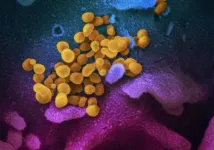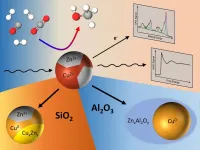(Press-News.org) Researchers in Japan have developed the first wearable devices to precisely monitor jaundice, a yellowing of the skin caused by elevated bilirubin levels in the blood that can cause severe medical conditions in newborns. Jaundice can be treated easily by irradiating the infant with blue light that breaks bilirubin down to be excreted through urine. The treatment itself, however, can disrupt bonding time, cause dehydration and increase the risks of allergic diseases. Neonatal jaundice is one of the leading causes of death and brain damage in infants in low- and middle-income countries.
To address the tricky balance of administering the precise amount of blue light needed to counteract the exact levels of bilirubin, researchers have developed the first wearable sensor for newborns that is capable of continuously measuring bilirubin. In addition to bilirubin detection, the device can simultaneously detect pulse rate and blood oxygen saturation in real time.
Led by Hiroki Ota, associate professor of mechanical engineering in Yokohama National University's Graduate School of System Integration, and Shuichi Ito, professor of department of Pediatrics in Yokohama City University's Graduate School of Medicine, the team published their results on March 3 in Science Advances.
"We have developed the world's first wearable multi-vital device for newborns that can simultaneously measure neonatal jaundice, blood oxygen saturation and pulse rate," Ota said, noting that jaundice occurs in 60 to 80% of all newborns. "The real-time monitoring of jaundice is critical for neonatal care. Continuous measurements of bilirubin levels may contribute to the improvement of quality of phototherapy and patient outcome."
Currently, medical professionals use handheld bilirubinometers to measure bilirubin levels, but there is not a device that can simultaneously measure jaundice and vitals in real time.
"In this study, we succeeded in miniaturizing the device to a size that can be worn on the forehead of a newborn baby," Ota said. "By adding the function of a pulse oximeter to the device, multiple vitals can easily be detected."
Held to the baby's forehead by a silicone interface, the device has a lens capable of efficiently transmitting lights to neonatal skin via battery-powered light-emitting diodes, commonly known as LEDs.
"At the present stage, coin cell batteries are used, and the overall shape is very thick," Ota said. "In the future, it will be necessary to further reduce the thickness and weight by using thin-film batteries and organic materials."
The researchers tested the device on 50 babies, and they found that the device is not currently accurate enough to suffice for clinical decision-making. According to Ota, they will reduce the thickness and increase the flexibility of the device, as well as improve the silicone interface to facilitate better skin contact.
In the future, the researchers plan to develop a combined treatment approach that pairs a wearable bilirubinometer with a phototherapy device to optimize the amount and duration of light therapy based on continuous measurements of bilirubin levels.
INFORMATION:
Co-authors include first author Go Inamori, Umihiro Kamoto, Fumika Nakamura, Ryosuke Matsuda and Masaki Shimamura, Department of Mechanical Engineering at Yokohama National University; Yutaka Isoda, Graduate School of System Integration at Yokohama National University; Azusa Uozumi and Shuichi Ito, Department of Pediatrics, Graduate School of Medicine, Yokohama City University; and Yusuke Okubo, Division of Cellular and Molecular Toxicology, Biological Safety and Research Center, National Institute of Health Sciences.
The Japanese Science and Technology Agency, Takeda Science Foundation Life Science Research Grants, MIC/SCOPE, the Ogasawara research grant and Japan Agency for Medical Research and Development funded this work.
Yokohama National University (YNU or Yokokoku) is a Japanese national university founded in 1949. YNU provides students with a practical education utilizing the wide expertise of its faculty and facilitates engagement with the global community. YNU's strength in the academic research of practical application sciences leads to high-impact publications and contributes to international scientific research and the global society. For more information, please see: https://www.ynu.ac.jp/english/
On Earth, plate tectonics is not only responsible for the rise of mountains and earthquakes. It is also an essential part of the cycle that brings material from the planet's interior to the surface and the atmosphere, and then transports it back beneath the Earth's crust. Tectonics thus has a vital influence on the conditions that ultimately make Earth habitable.
Until now, researchers have found no evidence of global tectonic activity on planets outside our solar system. A team of researchers led by Tobias Meier from the Center for Space and Habitability (CSH) at the University of Bern and with the participation of ETH Zurich, the University of Oxford and the National Center of Competence in Research NCCR PlanetS has now found evidence of the flow patterns inside ...
Female gannets travel further than male gannets to find fish for their chicks in some years but not others, new research shows.
Scientists tracked breeding gannets from Grassholm Island in Wales over 11 years with tiny GPS devices and by measuring isotopic signatures in their blood.
Male gannets flew an average of 220km to forage for their chicks, while females averaged 260km. Some birds travelled 1,000km on a single trip.
The scientists also found that the two sexes selected different habitats and foraged at different times of day, but some years ...
COLUMBUS, Ohio - Putting a price on producing carbon is the cheapest, most efficient policy change legislators can make to reduce emissions that cause climate change, new research suggests.
The case study, published recently in the journal Current Sustainable/Renewable Energy Reports, analyzed the costs and effects that a variety of policy changes would have on reducing carbon dioxide emissions from electricity generation in Texas and found that adding a price, based on the cost of climate change, to carbon was the most effective.
"If the goal is reducing carbon dioxide in the atmosphere, what we found is that putting a price on carbon and then letting suppliers and consumers make their ...
In order to show the clinical relevance of a difference between two treatment alternatives, in recent years, the manufacturer dossiers submitted in early benefit assessments of new drugs have increasingly contained responder analyses for patient-relevant outcomes. In such analyses, it is investigated whether the proportion of patients experiencing a noticeable change in the respective outcome differs between the two treatment groups in a study. This involves information on health-related quality of life or on individual symptoms such as pain or itching, which patients recorded with the help of scales in questionnaires.
But what difference makes a change relevant for the individual? That is, at what threshold can a response to an intervention be derived for ...
A deep sequencing study of 747 SARS-CoV-2 virus isolates has revealed mutant peptides derived from the virus that cannot effectively bind to critical proteins on the surface of infected cells and, in turn, hamper activation of CD8+ killer T cells that recognize and destroy these infected cells. These peptides, the authors say, represent one way the coronavirus subverts killer T cell responses and stymies immunity in the host. Their results may be of particular importance for SARS-CoV-2 subunit vaccines, such as the RNA vaccines currently in use, which induce responses against a limited number of viral ...
There are no therapeutics available that have been developed for COVID-19 treatment. Repurposing of already available medication for COVID-19 therapy is an attractive option to shorten the road to treatment development. The drug Camostat could be suitable. Camostat exerts antiviral activity by blocking the protease TMPRSS2, which is used by SARS-CoV-2 for entry into cells. However, it was previously unknown whether SARS-CoV-2 can use TMPRSS2-related proteases for cell entry and whether these proteases can be blocked by Camostat. Moreover, it was unclear whether metabolization of Camostat interferes with antiviral activity. An international team of researchers around Markus Hoffmann and Stefan Pöhlmann ...
Solving a Genetic Mystery at the Heart of the COVID-19 Pandemic
As the COVID-19 pandemic enters its second year, scientists are still working to understand how the new strain of coronavirus evolved, and how it became so much more dangerous than other coronaviruses, which humans have been living alongside for millennia.
Virologists and epidemiologists worldwide have speculated for months that a protein called ORF8 likely holds the answer, and a recent study by Berkeley Lab scientists has helped confirm this hypothesis.
In a paper published in mBio, lead author Russell Neches and his colleagues ...
By embedding a silver catalyst inside a porous crystal, KAUST researchers have improved a chemical reaction that converts carbon dioxide (CO2) into carbon monoxide (CO), which is a useful feedstock for the chemical industry.
Carbon monoxide is a building block for producing hydrocarbon fuels, and many researchers are searching for ways to produce it from CO2, a greenhouse gas emitted by burning fossil fuels. One strategy involves using electricity and a catalyst to drive a so-called CO2 reduction reaction. But this reaction typically produces a variety of other products, including methane, methanol and ethylene. Separating these products significantly raises the cost of the process, ...
A study on big droughts in the Greater Mekong region revealed findings that can help reduce the carbon footprint of power systems while providing insights into better designed and more sustainable power plants.
The study, titled 'The Greater Mekong's climate-water-energy nexus: how ENSO-triggered regional droughts affect power supply and CO2 emissions', was published by researchers from the Singapore University of Technology and Design (SUTD) and the University of California, Santa Barbara, in the journal Earth's Future.
Known as an important means to support economic growth in Southeast Asia, the hydropower resources of the Mekong River Basin have been largely exploited by the riparian countries. The researchers ...
The current commercial production of methanol through the hydrogenation of the green-house gas CO2 relies on a catalyst consisting of copper, zinc oxide and aluminum oxide. Even though this catalyst has been used for many decades in the chemical industry, unknowns still remain. A team of researchers from the Interface Science Department of the Fritz-Haber-Institute of the Max Planck Society, the Ruhr-University Bochum, Stanford Linear Accelerator Center (SLAC), FZ Juelich and Brookhaven National Laboratory have now elucidated the origin of intriguing catalytic activity and selectivity trends of complex nanocatalysts ...







